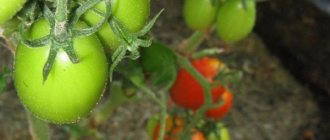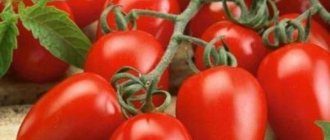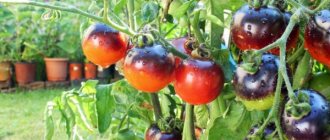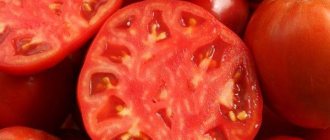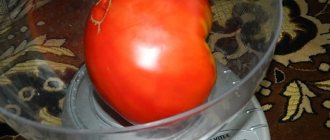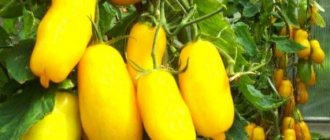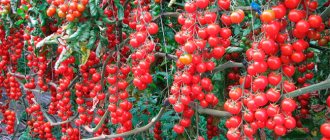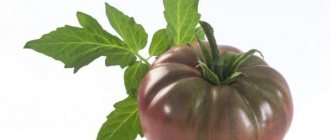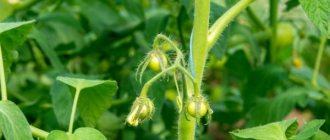Pros and cons of the Polfast tomato variety
The hybrid tomato variety Polfast F1 gives a good harvest if the minimum requirements of agricultural technology are met. Its advantages include the compact size of the bush, the ability to grow in open ground and under film cover.
The plant is resistant to tomato diseases - verticillium and fusarium. Tolerates unfavorable climatic conditions. The advantages of Polfast F1 tomatoes are:
- pleasant, sweet taste of fruits;
- beautiful presentation;
- possibility of universal use of the crop.
No cons were identified.
Polfast tomatoes from Gavrish on video
You can see other interesting varieties and hybrids of tomatoes with photos, descriptions and reviews in our Tomato Catalog. Enjoy watching.
If you grew Polfast f1 tomatoes, please write what the yield and taste of the fruit were in your climatic conditions? Would you grow this tomato again and recommend it to others? How do you assess the hybrid's resistance to disease? If possible, attach to the comment a photo of the entire bush as a whole or individual fruits that you grew. Thank you!
Your reviews of the Polfast tomato and additions to the description will help many gardeners evaluate this hybrid more objectively and decide whether it is worth planting or not.
Website about tomatoes - Tomatland.
Optimal growing conditions
Tomatoes Polfast F1 are light-loving plants, so choose a sunny place for planting. In the hope of a good harvest, it is necessary to take care of the fertility of the site in advance and introduce rotted organic matter in the fall. Plants do not develop well in poor soil. The optimal temperature for growing Polfast F1 tomatoes is from 16 to 28 °C.
Important! If the nights are cold, it is advisable to cover the bushes with film, lifting it during the day for ventilation.
Moderate but regular watering, fertilizing, weeding, and preventive treatments against diseases and pests are required.
Diseases and pests
The Polfast F1 tomato variety is resistant to major diseases. Before sale, seeds are treated with drugs that increase plant immunity. To prevent fungal and viral diseases, young plants can be sprayed with a weak solution of potassium permanganate or phytosporin. At the first signs of late blight, plants are treated with copper-containing preparations.
Simple preventive measures will help prevent diseases : loosening the soil, killing weeds, moderate but abundant watering in warm weather.
Polfast is a good choice for beginning gardeners living in regions with cool climates. Fruit ovaries are successfully formed at low temperatures, and the collected fruits ripen without problems at home.
| Mid-early | Super early | Mid-season |
| Ivanovich | Moscow stars | Pink Elephant |
| Timofey | Debut | Raspberry Onslaught |
| Black truffle | Leopold | Orange |
| Rosaliza | President 2 | Bull forehead |
| Sugar giant | Pickling miracle | Strawberry dessert |
| Orange giant | Pink Impression | Snow fairy tale |
| One hundred pounds | Alpha | Yellow ball |
If you find an error, please select a piece of text and press Ctrl+Enter.
Agricultural technology of tomatoes variety Polfast F1
The seedling method is the most convenient and economically profitable for growing Polfast F1 tomatoes. Sowing of seeds is carried out in March. And grown seedlings are transplanted into open ground in May, when the air and soil warm up.
To get a good harvest, they try to provide proper care:
- form the bush correctly;
- remove excess stepsons in a timely manner;
- maintain soil fertility;
- carry out timely and competent feeding;
- water with warm water as needed.
Preventive treatments against pests and diseases help avoid crop loss. Good results in the fight against late blight and weeds are obtained by mulching the soil under Polfast F1 tomatoes with hay, grass clippings or peat of neutral acidity.
Growing seedlings
Growing Polfast F1 tomatoes begins with pre-treatment of seeds. To do this, they are placed in gauze bags and dipped in a cherry-colored potassium permanganate solution. Leave for 15 minutes and then wash with water. If the seeds are green or blue, it means they have undergone preliminary preparation before packaging and do not need to be treated with potassium permanganate or soaked.
The order of sowing seeds for seedlings:
- The soil in the planting container is moistened and slightly compacted.
- The seeds are laid out in a row and sprinkled with a 1 cm layer of dry soil.
- Cover with film or glass and place in a warm place.
- With the appearance of the first shoots, move the container to a bright windowsill.
- When the seedlings have two true leaves, they are planted in 200 g glasses.
- As they develop, they are transplanted into large containers. If they want to get an early harvest, they practice picking in large pots with a volume of 3-5 liters.
In order for young seedlings to take root well in open ground, it is important to prepare them for planting. A few days in advance, preventive spraying with Bordeaux mixture (1%) is carried out to protect against fungal diseases. Tomato seedlings Polfast F1 are transplanted at the end of May, having first watered the bed with water. It is advisable to do this in the evening so that the plants become stronger overnight.
Landing rules
Polfast F1 tomatoes respond well to the high content of rotted organic matter, potassium and nitrogen in the soil. It is better to prepare the bed in the fall, adding garden compost, crushed eggshells and wood ash when digging.
Unlike most vegetables, Polfast F1 tomatoes, as described by experienced gardeners, prefer slightly alkaline soil. When choosing a place to plant, we must not forget about the rules of crop rotation. A bad predecessor is potatoes, which also belong to the Solanaceae family. A common disease for these plants is late blight.
It is better to plant tomatoes after the following crops:
- cabbage;
- onion;
- legumes;
- beet.
Tomato seedlings Polfast F1 are placed in a well-lit place where there is no stagnant water.
Advice! To attract pollinating insects to the beds, you can plant bright annual honey plants between the rows. For example, bergamot can not only attract butterflies, but also improve the taste of tomatoes.
There are various planting patterns - in rows, in a checkerboard or square-cluster pattern, the choice depends on the desire of the vegetable grower. In the first option, the distance between the holes is 30-40 cm, between the rows - about 50 cm.
Watering and fertilizing
Polfast F1 tomatoes need moderate but regular moisture. When watering, it is important to avoid getting drops on the leaves, trunk and fruits. It is optimal to arrange a drip irrigation system for Polfast F1 tomatoes. When using a regular watering can, it is better to water the plants rarely, but abundantly.
Excess nitrogen in tomato beds causes curling of the leaves, thickening of the stem, strong growth of stepsons and a delay in fruiting. Nitrates accumulate in ripened fruits. In low light and low air temperatures, these substances turn into nitrites, which are hazardous to health. Fertilizers with superphosphate will help correct the situation. During the season, at least 4 feedings are made:
- at the beginning of seedling development;
- after transplantation into open ground;
- before flowering;
- during fruit ripening.
Tomatoes Polfast F1, which are stunted in growth, are given leaf feeding with complex fertilizers in cloudy weather or in the evening.
Pinching and tying
Side shoots or stepsons grow on Polfast F1 tomatoes from the base of each leaf. In 3-4 days they reach significant sizes, robbing the plant of the forces necessary for growth and the formation of flower buds. During intensive seedling growth, it is advisable to inspect the bushes daily and break off excess side shoots with your hands, leaving stumps of about 1 cm.
Determinate Polfast F1 tomatoes do not need tying. Their growth is limited, the height of the bush does not exceed 60 cm. A flower cluster is formed at the top of the stem. When the fruits begin to form, it is worth tying them to additional support so that the tomato clusters do not break under their own weight.
Formation
Determinate tomatoes such as Polfast should preferably be formed into 3 stems. For this, 3 stepsons are left, which then turn into powerful shoots. When growing low-growing tomatoes with 3 stems, the yield from one bush is at least 4.5-6 kg.
At the beginning of formation, the leaves that are in contact with the ground and the lower stepsons are removed, leaving stubs of about 1 cm. Select the two strongest lateral shoots under the first flower cluster and above. Two additional stems are formed from them.
Protection from diseases and pests
To prevent fungal diseases, use an infusion of garlic with the addition of potassium permanganate. Spraying is carried out before flowering, then repeated when the second flower cluster appears. Insecticides are used against pests.
Attention! If the fruits have already set, use a biologically based preparation – “Fitoverm”, at air temperatures above +18 °C. It is non-toxic to humans, but it is good at destroying tomato pests - spider mites, aphids, and Colorado potato beetles.
Among the diseases of Polfast F1 tomatoes, in addition to fungal and viral ones, there are non-infectious ones. They arise due to improper care. For example, during fruit filling and ripening, tomatoes should not be given too much water. The fruits may become deformed and crack.
Advantages and disadvantages, differences from similar varieties
Although the Polfast tomato is more than ten years old, it is still considered a very good choice for lovers of even tomatoes without any special frills of classic shape and color. And although its productivity cannot be considered high, the hybrid never fails and produces what is “supposed” without requiring anything supernatural from the owner. A distinctive feature of the hybrid is a very thin, but at the same time durable skin, which is not felt when eating tomatoes, but allows them to withstand transportation well and be stored in cool rooms. In this regard, the hybrid is used not only by summer residents, but also by farmers who grow vegetables for commercial purposes.
The advantages of the Polfast tomato are:
- high resistance to most known diseases;
- compactness of the bush, making it easier to care for;
- normal tolerance to cold temperatures and drought;
- evenness, “chiseness” of fruits;
- excellent taste;
- early ripeness;
- good transportability and keeping quality of the crop;
- friendly release of the first portion of fruits and continued small fruiting in the future.
Capricious gardeners call the disadvantage that this is a first-generation hybrid, and therefore you cannot sow seeds from your own harvest. But this is the “trouble” of any hybrid tomatoes. In addition, it has been noted that the yield of the hybrid very much depends on the degree of soil fertility.
There are now a lot of tomatoes with fruits of a similar shape, the same size and purpose; many Dutch hybrids from the same company can be found in our gardens. They are not always “head and shoulders” better than their domestic counterparts; some are nothing special at all. In this series, Polfast is not bad at all. So, if we compare it with the mid-late hybrid, which has a similar name Polbig, then Polfast has more tasty fruits, although many of their characteristics are similar. They are also tastier in comparison with the fruits of the older Tolstoy hybrid, which bears fruit in similar periods. Most Dutch hybrids are cold-resistant and can set fruit in any weather. And among them, Polfast is, perhaps not the best, but one of the best representatives.
Many Dutch hybrids look very similar to each other, but differ in nuances
Growing Tips
Tomato is not a very demanding crop, but some conditions must still be observed when growing, otherwise the harvest may be far from expected.
This culture has several basic requirements:
- Air temperature. This characteristic is extremely important for tomatoes. Tomatoes are quite hardy, but grow better in areas where the climate is moderate. The minimum temperature for seed germination is 9 °C; intensive growth is possible when the temperature range reaches 18 – 25 °C. With a sudden and strong increase in temperature, growth may slow down, and in some cases stop altogether. The average value considered optimal for early varieties of tomatoes is 24 °C.
- The soil. Tomatoes can grow equally well in different types of soil. Successful cultivation is more possible in soils rich in humus. Good drainage and no hyperacidity are important.
- Fertilizer. Before transplanting Polfast seedlings (when digging the soil), it is necessary to apply organic fertilizer, and then repeat fertilizing twice during the season. When planting plants, you should not add organic matter: as a result, you will get a lush green bush, but not a rich harvest. In addition, feeding Polfast with organic matter directly into the holes during planting will contribute to the development of fungal diseases.
If the soil is fertile, it is enough to apply fertilizers containing potassium and phosphorus: these microelements have a positive effect on the development of the root system, promote abundant and earlier flowering and high-quality ripening of tomatoes.
When thinking about fertilizer for Polfast tomatoes, you can use wood ash as an option. Some types of fertilizing go well with watering: these two procedures can be done simultaneously.
Tomato reviews
Maria Nikolaevna, Nizhny Novgorod:
I bought the seeds for the first time last summer after reading reviews in the local newspaper. I was satisfied, because Polfast is a very productive, meaty and tasty tomato. I planted it both in the greenhouse and in the garden bed so that the first tomatoes would ripen earlier and a little later. They turned out sweeter in the greenhouse than outside, I’ll take this into account when I plant this variety again.
Evgeniy Petrovich, Kemerovo:
Our conditions for tomatoes are not very suitable, but Polfast unexpectedly pleased us with a bountiful harvest. This is an excellent hybrid variety, although this is not Holland. It grew right in the garden bed and began to ripen in mid-July, despite the constant rains. The first tomatoes cracked due to excess moisture, but then they stopped and sang together and without loss.
Anna, Novosibirsk:
Polfast is a high-yielding tomato, I didn’t regret buying the seeds. It does not need any care, I don’t go to the dacha very often, the bushes only needed to be watered when there is no rain. The fertilizer was mixed with the soil during digging, so there was no need to feed it. About 1 bucket of tomatoes was collected from 5 bushes.
Transplantation and care
Picking plants, that is, replanting them, is carried out when two formed leaves appear on them. During the same period, fertilizing is carried out with a complex mineral fertilizer, which includes potassium, phosphorus, nitrogen and other elements. After a few days, the tomatoes are tied up. Fruiting in open ground usually begins after 50–54 days. Softened, warm water should be used for irrigation; drying out of the soil is unacceptable.
Seedlings must be planted correctly by performing the following steps:
- when planting in open soil, a distance of half a meter is maintained between plants;
- if there is a picking in the greenhouse, the interval between tomatoes can be reduced to 20–30 cm;
- Holes up to 30 cm deep are dug in the ground, the roots of 2-3 branches are placed there, after which the crop is watered, which ensures high fruitfulness of the bush.
First, the tomato grows rapidly in height, after which growth occurs around the roots. Optimal watering of the plant is up to six times a month; during rains, the hybrid needs additional fertilization with nitrogen compounds. If tomatoes are grown in a hot, dry area, the root system will need to be irrigated every two days.
A few weeks before harvesting, it is necessary to stop applying fertilizers to the soil, and if spraying against diseases and pests is necessary, then only natural, harmless products are used.
Brief information about the variety
- Bush : low-growing, determinate; height in open ground 55-65 cm, in a greenhouse up to 50 cm.
- Fruits : when ripe, bright red, round, weight 100-140 g; grow in clusters of 4-7 pieces.
- Productivity : 3-6 kg per m².
- Resistance : resistant to infectious diseases and pests; tolerates sudden temperature fluctuations well.
- Distribution : distributed in the northern and central regions.
- Application : used for canning and raw in salads, soups and side dishes; They are actively used on an industrial scale to create juices and sauces.
- Planting : use seedling method of cultivation; in the second half of March the seeds are planted, and in the last days of May they are transplanted into open ground.
- Soil : light and turfy soil containing nitrogen fertilizers.
- Care : watering as the top layer of soil dries; Fertilize 1-2 times a month.
- Ripening period : the time from germination to ripening is 86 – 91 days.
Features of cultivation and storage
Seedlings are planted after reaching 55-60 days from germination. Choose a sunny site.
The soil is fertilized in advance, for this purpose the following is added per 1 m2:
- 1 bucket of compost;
- 1 glass of ash;
- 20 g of phosphorus-potassium mixture.
To reap the maximum harvest, follow simple care rules:
- Bushes are formed into 2-3 shoots.
- Water moderately, the norm is 6-8 liters per root.
- Mulch with straw, sawdust, and green manure crops.
Fertilizing must be carried out at the stage of flowering and ripening. Solutions of manure and mullein diluted 1:10 give a good effect. Additionally, bioinfusions and infusions of eggshells are used. Don't forget about potassium sulfate and superphosphate.
Description of the variety
Polfast is an early variety that produces fruits already 3 months after germination. A powerful course reaches a height of 55 - 60 centimeters, has a medium-sized leaf, in some cases the foliage can be large. The inflorescence is simple.
Polfast variety tomatoes are a high-yielding variety. The green mass is formed quite moderately, the leaf is dark green in color and medium in size. The fruits ripen in clusters, with 4 to 6 pieces in one bunch. Productivity is high. One square meter can grow from 3.5 to 6.5 kilograms of juicy tomatoes. Each fruit weighs from 100 to 140 grams, changing color during ripening from green to bright red.
The skin is thin, but quite dense, protecting the fruit from cracking. There are very few seeds in the pulp, which is dense and juicy. The sweet taste of the fruit is not at all watery, rich. Due to the high content of sugar and vitamins, Polfast fruits are recommended for use in the diet of children.
Ripening of Polfast tomatoes occurs 55 days after the seedlings are moved into the ground. This period is approximate - you can see a ripe tomato a few days earlier or a little later. The ripening period is largely influenced by climatic conditions and agricultural technology.
A powerful branched plant reaches a height of 55 - 60 centimeters. The ovary can form even if temperatures are slightly lower than recommended. This means that the crop is more likely to produce a good harvest on time, being less dependent on the vagaries of the weather.
